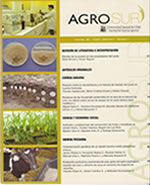Anthocyanins in Solanum tuberosum: A review
Main Article Content
Abstract
Anthocyanins are positively charged molecules of plant origin belonging to the flavonoid group, found in various pigmented varieties of Solanum tuberosum. The 6 most common anthocyanins found in potatoes are derivatives of pelargonidin, malvidin, petunidin, delphinidin, cyanidin and peonidin, in different concentrations. The distribution of anthocyanins in tubers is not uniform but differs between the skin and flesh, and it is associated with the distribution and intensity of colour. The anthocyanin content and antioxidant activity in Solanum tuberosum may vary with the genotype, environmental conditions, storage and the way of cooking the tubers, such as steaming or frying. Various properties of anthocyanins that are beneficial for humans have been studied, such as antioxidant, antitumor and antiviral properties. Several studies have shown that anthocyanins activate antioxidant systems in the liver, prevent the growth of colon cancer tumour cells, among other cancers.

